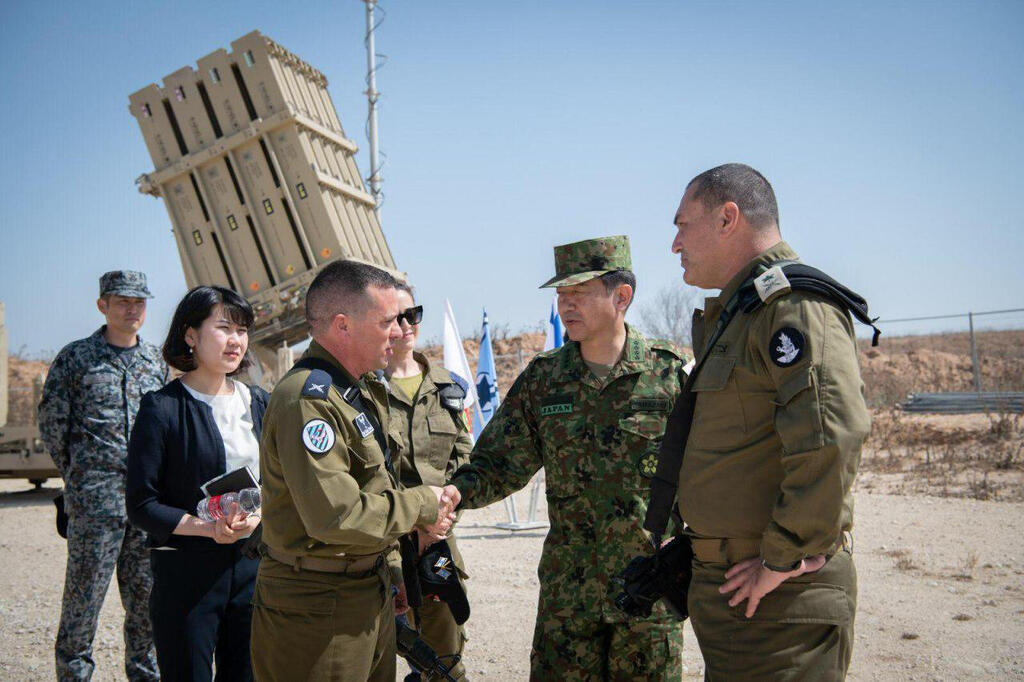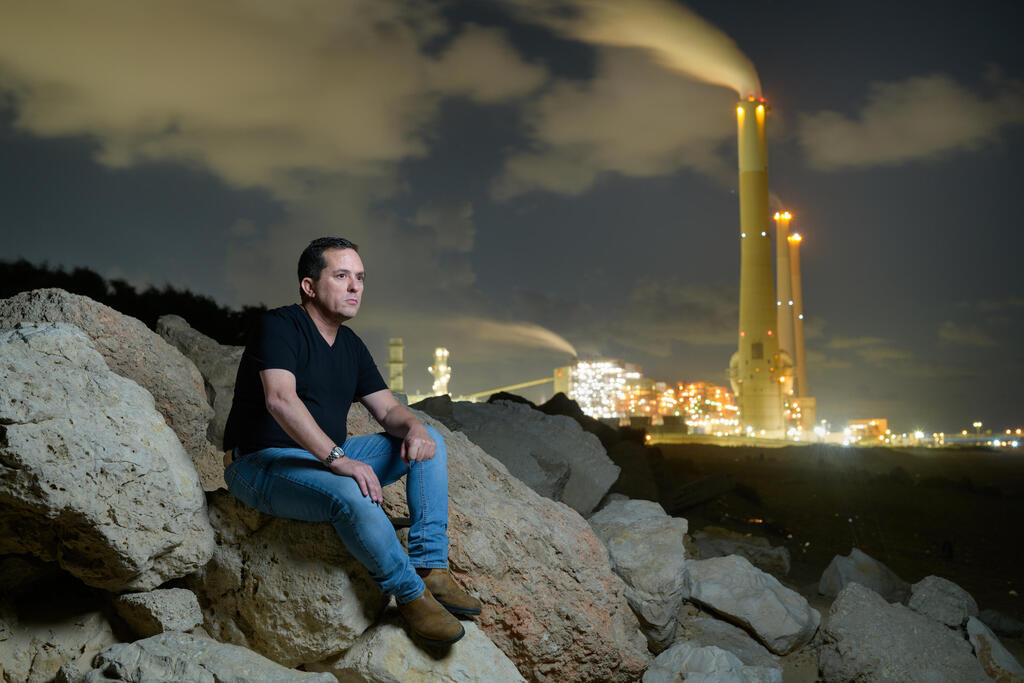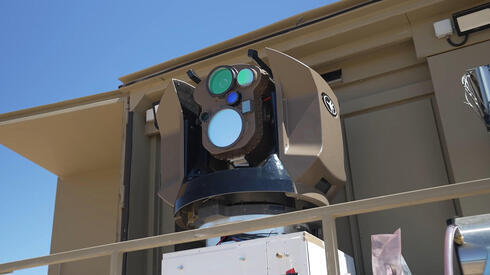
"Laser technology is a true game-changer. There are applications we haven’t yet conceived of"
Brigadier General Ran Kochav, former commander of the Israeli Air Missile Defense Forces, believes that the introduction of Iron Beam, a laser interception system, heralds a profound change in warfare and believes that the day is not far off when fighter jets will be able to destroy ground targets from the air with total silence and precision.
Brigadier General (res.) Ran Kochav, a former commander of the Israeli Air Missile Defense Forces, refuses to ride the wave of euphoria dominating the public discourse surrounding the laser-based Iron Beam defense system, which will be delivered to the IDF next year and enter operational use. Last week, the Ministry of Defense signed a contract with Rafael and Elbit Systems for an order valued at approximately NIS 2 billion ($533 million) to purchase the world’s first system of its kind for intercepting short-range rockets at nearly zero cost. It’s important to note that the system is the result of a technological breakthrough following decades of research and development, positioning Israel where even superpowers have struggled.
However, Kochav, who retired last summer from the IDF after 35 years, most of which he spent in the Air Defense Corps, expresses reservations about the public’s expectations. "Our problem is that we inflate expectations. Every success here is seen as a triumph and every minor failure is considered a debacle," he says in an interview with Calcalist.
"I come from the air defense world and am very familiar with the paradox of success. Take, for instance, the drone threat. We intercept 80% of them, but if we miss one or two, people immediately claim it was a failure. But that’s not the case. A true failure was October 7 - that’s the ultimate debacle. We have a 90% success rate in intercepting rockets and missiles that we want to shoot down. Still, for those who are hit by a drone, missile, or rocket that wasn’t intercepted, there’s no success, because they were harmed. Nothing is perfect; there’s no such thing as an airtight defense."
Even with a laser?
"Correct. The laser will solve many problems for us, but not all of them. Technologically, we’re getting closer to a solution, but there’s a safety issue: the laser beam is not selective, and it burns anything in its path - say, an aircraft that you don’t want to hit. Beyond that, it has efficiency limitations in certain weather conditions - haze and clouds reduce its effectiveness. The beam also doesn’t follow a ballistic trajectory like a missile does, meaning it requires line of sight to the target."
Still, the cost of interceptions will be greatly reduced. Currently, an Iron Dome missile costs around $50,000 to intercept a rocket that costs only a few hundred dollars.
"There's no doubt that this will be a fantastic defense system, a marvel of technological innovation that will reduce interception costs by several degrees. It will serve as an excellent complement to Iron Dome, but it’s advisable to set realistic expectations with the public - it won’t solve all our problems. Let’s tone it down."
A new kind of warfare
The recent breakthrough by Israeli defense industries is driven by a persistent need, similar to what led to the development of Arrow by Israel Aerospace Industries, and Rafael’s Iron Dome, David’s Sling and Trophy which protects tanks and armored vehicles from anti-tank missiles and RPGs. While, at least in its initial deployment, Iron Beam will have limited capabilities in range and operations amid challenging weather conditions, it establishes Israel as a pioneer in high-powered laser weaponry.
Turning the Iron Beam system operational may also carry historic significance, marking the beginning of a shift to a new type of weapon that has so far existed only in science fiction. If this vision is realized, armies will no longer need massive missiles carrying hundreds of kilograms of explosives that soar beyond the atmosphere to strike distant targets, nor metallic projectiles fired at supersonic speeds with thunderous noise. Even target destruction would no longer create an ear-splitting explosion.
This won’t happen in the next year or two, but laser technology is here, and it will form the basis for additional weaponry developed and manufactured in the coming years. Defense industry engineers are already likely envisioning laser-based offensive systems that will reshape future battlefields, even if the development plans remain classified. In the near term, the primary efforts will focus on defense to neutralize a wide array of airborne threats: from hostile fighter jets to missiles, rockets, and even drones, attacking UAVs, and anti-tank missiles in mid-flight. Rafael is still working on the ground-based version of the Iron Beam, preparing it for integration into Iron Dome batteries.
4 View gallery


Kochav with the Chief of Staff of the Japanese Army Koji Yamazaki visiting the Iron Dome battery in 2019.
(Credit: IDF Spokesperson's Unit)
Meanwhile, Elbit is developing an airborne version, potentially replacing the missiles currently used to down hostile aircrafts, missiles, and UAVs. In this case, the limitations of a ground-based system become advantages, as firing the laser above the cloud layer enables the system to be effective at a longer range. For this vision to come to fruition, Elbit’s engineers must overcome technological challenges such as shrinking the laser’s guidance system and power sources to enable installation on various aircraft, and stabilizing the light beam as it’s directed from one maneuvering aircraft to another. In recent days, defense industry leaders have hinted that the hardest parts of these challenges are already behind them.
Perhaps because of this, when asked about the future capabilities emerging in the secret labs of Israeli weapons companies, Kochav sheds the restraint he showed regarding Iron Beam and eagerly explains how this innovative system could integrate into the IDF’s air defense array. “Imagine a scenario where an enemy from the north wants to attack Hadera’s power station. Ideally, we’d aim to neutralize this threat before it even takes off, eliminating its launch capability. If the missile or UAV is launched anyway, we would intercept it before it crosses into Israeli territory using a forward-facing laser, thereby avoiding 4 a.m. alarms. Just for that, it’s worth it.”
And if the threat has already crossed the border and is advancing towards its target?
“In that case, we’d have a double defense. On its way to the target, the threat would encounter an interceptor from a defense battery like Iron Dome, and if it managed to evade that, it would face another laser interceptor near its target.” In a reality where air defense systems sometimes struggle to track hostile aircraft breaching Israeli airspace, this vision seems almost fanciful. Yet, technologists are already thinking of the next phase: using laser technology as an offensive weapon.
“Currently, we hope that this technology can significantly reduce the missile, aircraft, and rocket threat, but in the future, we envision additional applications we haven’t yet conceived of. For instance, if a laser beam can be directed from the ground to a target in the air, or from one target in the air to another, why shouldn’t we fire it from the air to the ground as well? In fact, we already do this when we designate a target with a laser for a laser-guided missile. So, why shouldn’t the laser spot itself be the weapon rather than the missile? Such adjustments turn this into a true game-changer. The technology is already proven. Now, efforts are underway to apply it across different weapons systems.”
Using such systems would also allow for significant cost savings in an era in which demand for weapons is only increasing.
“Absolutely, and that’s the third hopeful aspect of laser-based weapons. Kinetic defense as we know it today is costly and complex. If laser weaponry eventually replaces or complements it, the cost per interception will be lower than the cost of the incoming rocket, reversing the equation. Currently, defensive weaponry costs more than most offensive weapons it counters.”
Would this also redefine economics of arms?
“Completely. There will be geopolitical implications because we won’t need extensive foreign weapons support. Also, if we encounter a simultaneous attack on Hadera and Caesarea, we won’t need to quickly decide which target is more important to defend, as we won’t face the limitations imposed by finite interceptor inventories.”
A fast-changing future
Future warfare, in which laser weapons become standard, will be silent and precise. “This kind of war will be very quiet and conducted at extremely high speeds,” says Kochav. “The laser beam is invisible to the naked eye, there won’t be a sound of explosions because the beam launch is silent, and even the impact on the target will look different. In this scenario, there’s no explosive involved but a concentration of energy in a beam the size of a 10-shekel coin or even smaller. There will be a target and then it will simply disappear,” he explains.
And when the beam intercepts targets in the air, will there be no explosions or smoke?
“Exactly. The laser beam will hit the target at the speed of light, in fractions of a second. It will heat the target’s exterior, melt parts of it, and the target will just fall to the ground as debris. In future operational applications, it will be possible to control the beam’s power and focus more energy for a large target and less for a smaller one.”
According to Rafael, Iron Beam’s main contractor, the laser’s power, currently planned for 100 kilowatts, may become stronger, more stable, and deadlier in the future. To meet these objectives and create a product portfolio based on lasers for global military markets, Rafael is partnering with U.S. defense giant Lockheed Martin. This collaboration signifies American recognition that Israel leads in this field and Israel could soon become the first country to implement a reliable and efficient operational military laser system.
However, Israel is not the only country advancing in laser weaponry. Earlier this year, the British Ministry of Defense announced that it had conducted a series of tests in Scotland, firing a laser at an airborne target for the first time. Recently, reports have emerged of robust Chinese activity in the field, and there are indications that Iran has acquired a Chinese-made laser system providing some defense against drones and UAVs. While its capabilities are far behind those of the Iron Beam in terms of range and power, Iran’s motivation to develop similar capabilities to Israel’s should not be underestimated. In other words, although Israel currently leads the competition, there’s no guarantee that other determined nations won’t eventually acquire similar technology.
The drone threat - a major concern for the Israeli Air Force - is an example of how advanced technologies can quickly filter down to terror organizations. Just a decade or two ago, UAVs were the domain of technologically advanced countries like Israel and the U.S., but in recent years, new players like China, Iran, and Turkey have joined, making drones widely available, affordable, and sought-after weapons. Iranian drones have become a significant part of Russia’s offensive arsenal in Ukraine and are supplied generously to proxy organizations Hezbollah, the Houthis, and Iraqi militias which form the “ring of fire” around Israel.
We can assume that our current technological superiority will be short-lived and soon we’ll have to develop defense systems against laser weapons as well.
“Just as we planned today’s air defense system 20 years ago - which in 2024 is performing very well - it’s wise for knowledgeable experts to start thinking now about the air defense Israel will need in 2048, when laser weapons will be a significant part of the battlefield. We should prepare for our enemies to possess such weapons too. Just as we’ll use lasers to protect the power station stacks in Hadera, lasers will protect energy facilities in Tehran. Alternatively, we must prepare for a scenario where a mysterious laser beam could take down a Boeing with hundreds of passengers as it lands at a British, American, or Israeli airport.”
Identifying the target
Until this futuristic vision becomes a reality, the most significant challenge the Air Force faces regarding drone attacks is the difficulty in detecting them before they hit their target. For instance, this past July, a drone launched from Yemen managed to hit a building near the U.S. Embassy in Tel Aviv and killed a civilian without being detected. Last month, a drone launched from Lebanon crashed onto the roof of the Golani Brigade's training base dining hall near Binyamina, killing four soldiers and injuring dozens. Another recent incident involved a drone launched from the north, which exploded on the window of the Prime Minister’s bedroom in Caesarea. In all these cases, no warning sirens were triggered.
From 2018-2021, you commanded the Air Defense Command when drones were already a concern. Why have such incidents happened?
"I take responsibility for this and I’m not blaming anyone else - not the Air Force commander or my successor in air defense command. I prioritized airborne threats second to the critical goal of responding effectively to missile and rocket threats. In the case of drones, I knew I’d get assistance from the Air Force’s primary mission: protecting Israeli airspace through fighter jets, attack helicopters, aerial control units, and electronic warfare tools. As the air defense commander, I understood I was solely responsible for missiles and rockets. If I didn’t focus on them, there would be a bloodbath due to missile and rocket fire targeting the home front. Budget limitations were tight, but despite our lesser capabilities in intercepting drones, I don’t see this as a failure. These decisions were sound."
Today, with a better understanding of the drone threat, would you decide differently?
"I don’t think so. Sure, more radars could have been deployed to improve detection, and more resources could have been allocated to this threat. But a limited budget doesn’t absolve me of responsibility, nor am I avoiding it. I’m responsible for the bad outcomes and for the good ones."
Were missile interceptions prioritized over drones because surface-to-surface missiles are deadlier than drones?
"I’m not minimizing the casualties from drone attacks. But the priority was to address existential threats like nuclear capabilities. And, even setting nuclear threats aside, a missile with a half-ton explosive warhead hitting this building we’re sitting in would create a crater. If a drone with five kilograms of explosives hit, you’d be injured, maybe even killed."
I was recently up north and saw an Israeli F-16 pursuing a drone launched from Lebanon at a very low altitude, trying to intercept it. It was heartbreaking.
"Forget heartbreaking; it’s dangerous. The fact that we haven’t had a fighter crash into the ground while pursuing such a drone is only thanks to our pilots' professionalism. A momentary lapse and you’re in the ground. A fighter jet chasing something that looks like a fly from the cockpit poses an enormous risk of disorientation."
Hezbollah has adopted a challenging tactic by launching drones amid rocket salvos, attempting to overwhelm defense systems with targets. How do you counter this?
"This is a significant challenge and there are defensive zones with set priorities, determining what’s most critical."
Who decides?
"Some decisions are made according to Air Force Command policy, while others are determined by the General Staff or political leadership."
Are there dilemmas?
"Certainly. If a target approaches the Ramat David base and another one nears Yokneam, which do you intercept first and which do you protect first? If you choose Ramat David, people might be killed in Yokneam, and if you prioritize Yokneam, the base could be hit. In these scenarios, priorities are established, but naturally, I can’t elaborate."
The poison machine effect
In the last two years of his service, Kochav was the head of the IDF Spokesperson's Unit. In March 2023, Brigadier General Daniel Hagari replaced him in the role. Last July, while he was supposed to be on study leave as a research fellow at RUSI in London, he unexpectedly announced his retirement. Today, he heads a company called Four Stars which provides consulting and business development services in air defense for European countries. “My relationship with Chief of Staff Herzi Halevi is good,” he says. “I informed him that I was going on retirement leave but I still keep a pair of shoes in my car and am ready to report for duty if needed. I closed the door behind me but didn’t slam it shut. I’m an IDF soldier for life, yet I have criticisms which I’ve shared with those who need to hear them.”
It’s been 13 months since the failure of October 7, and Halevi is still in his position. Wouldn’t it be better for him to step down?
“He should complete his term. I believe he knows this and just needs to find the right timing.”
What is the right timing?
“I think he should have already announced it and not just him. Other General Staff members should have resigned like the Head of Military Intelligence and the Commander of the Gaza Division did. This isn’t an unreasonable expectation.”
Investigations haven’t even been conducted yet. This undermines what public trust remains in the army.
“Other than the Be’eri investigation (regarding tank fire on a home in Kibbutz Be'eri), we haven’t seen a single serious investigation. The IDF Spokesperson said everything would be done with transparency but, it’s fair to ask, when? Public trust in the IDF was severely damaged on October 7 and it was already in crisis during the judicial overhaul when the debate revolved around whether these moves impacted military preparedness. The army remained silent on the issue but in situations like these there’s no vacuum. That void is filled by actors with special interests, usually politicians.”
What happened to us on that horrible morning?
“I have no idea. I personally feel responsibility, shame, and guilt, even though I left the army seven months before the attack, and although the three units I commanded in recent years (the IDF Spokesperson’s Unit, the Air Defense, and the Military Police) performed excellently. I feel ashamed in front of my children, three of whom are now serving in the army and are involved in the war effort. If they’re the generation of victory, then we’re the generation of failure and I feel like a part of that.”
In this war, Hagari has become the de facto national spokesperson. Do you think that’s appropriate?
“My view on this is different from most past IDF spokespersons.”
What’s your opinion?
“That he shouldn’t be the national spokesperson. It doesn’t serve the IDF or the Spokesperson’s Unit, because no matter what the IDF Spokesperson says, it never comes across well.”
If Hagari doesn’t speak, no one will. The prime minister only steps in front of the cameras when there are successes and achievements.
“We need to establish a law stating that it is the state that should communicate the activities of government ministries. It’s not the role of a uniformed officer to handle issues like civilian evacuations, nor is it the Northern Command general’s job to inform people whether they can return to their homes. When a uniformed officer addresses such questions, it’s not beneficial internationally, as people abroad see him as they would the military spokesperson for the Houthis.”
Like Hagari in recent months, Kochav also became a target of the right-wing’s poison machine during his service. At the end of 2022, a security guard was assigned to him for about two months, and his home in Caesarea was surrounded by cameras following threats on your life.
“All I said on air was that burning villages isn’t legal or ethical, it diverts the IDF’s focus, and - in my view - it’s not Jewish either. The entire poison machine was unleashed against me,” he says now.
Did you feel threatened?
“I didn’t think someone genuinely wanted to kill me, but when you get calls in the middle of the night which immediately hang up, and you’re personally attacked online, it’s unpleasant. Afterward, the same thing happened to Central Command Chief Yehuda Fox, and my security guard was transferred to him, and later to the Chief Military Advocate General, Major General Yifat Tomer-Yerushalmi. It’s unbearable, especially since no one knows my political views, and many of those making threats haven’t served in the army themselves. And if laws are passed to protect draft-dodging and break-ins at IDF bases, where are we headed?”
Where?
“Sde Teiman scares me more than Yemen. We’ll know how to handle the Iranians, but we won’t know how to handle a state that devours its own army. We’re sawing off the root that holds up the tree, and it’s dangerous. You asked why I retired last July and the answer is partly because it became unbearable to be a public servant.”
















